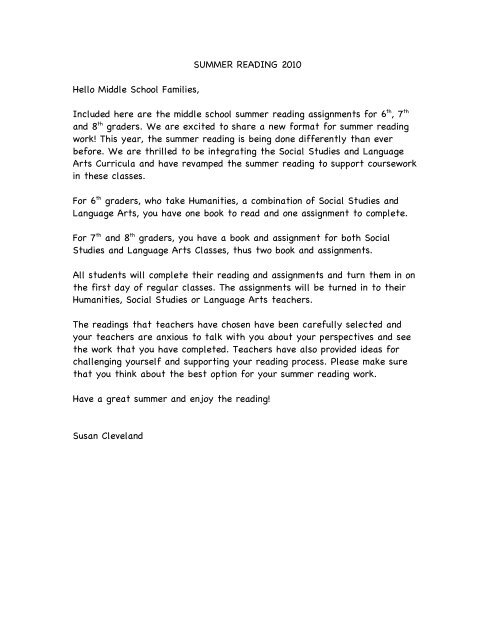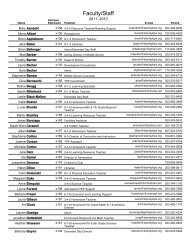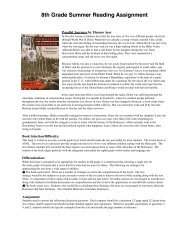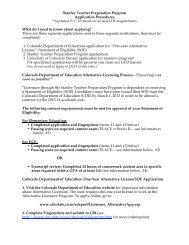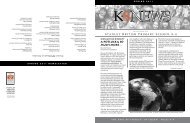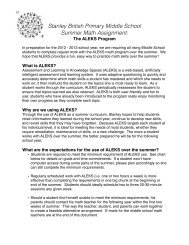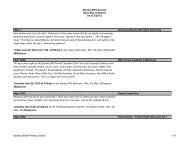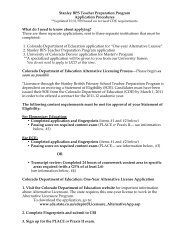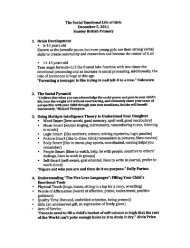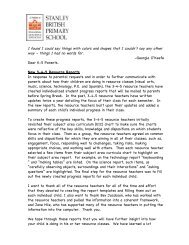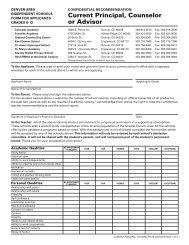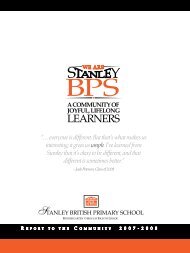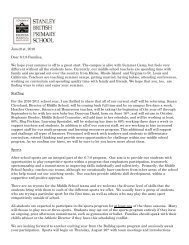8th Grade Summer Reading List
8th Grade Summer Reading List
8th Grade Summer Reading List
- No tags were found...
Create successful ePaper yourself
Turn your PDF publications into a flip-book with our unique Google optimized e-Paper software.
Hello Middle School Families,SUMMER READING 2010Included here are the middle school summer reading assignments for 6 th , 7 thand 8 th graders. We are excited to share a new format for summer readingwork! This year, the summer reading is being done differently than everbefore. We are thrilled to be integrating the Social Studies and LanguageArts Curricula and have revamped the summer reading to support courseworkin these classes.For 6 th graders, who take Humanities, a combination of Social Studies andLanguage Arts, you have one book to read and one assignment to complete.For 7 th and 8 th graders, you have a book and assignment for both SocialStudies and Language Arts Classes, thus two book and assignments.All students will complete their reading and assignments and turn them in onthe first day of regular classes. The assignments will be turned in to theirHumanities, Social Studies or Language Arts teachers.The readings that teachers have chosen have been carefully selected andyour teachers are anxious to talk with you about your perspectives and seethe work that you have completed. Teachers have also provided ideas forchallenging yourself and supporting your reading process. Please make surethat you think about the best option for your summer reading work.Have a great summer and enjoy the reading!Susan Cleveland
6th <strong>Grade</strong> <strong>Summer</strong> <strong>Reading</strong> AssignmentRocket Boys / October SkyBy Homer HickamInspired by Werner von Braun and his Cape Canaveral team, 14-year-oldHomer Hickam decided in 1957 to build his own rockets. They were histicket out of Coalwood, West Virginia, a mining town that everyone knewwas dying--everyone except Sonny's father, the mine superintendent and acompany man so dedicated that his family rarely saw him. Hickam's smart,iconoclastic mother wanted her son to become something more than aminer and, along with a female science teacher, encouraged the efforts ofhis grandiosely named Big Creek Missile Agency. He grew up to be a NASA engineer and hismemoir of the bumpy ride toward a gold medal at the National Science Fair in 1960--anunprecedented honor for a miner's kid--is rich in humor as well as warm sentiment.Book Selection/Difficulty:In the fall we start the year by looking at identity and the role that it plays in decision-making.<strong>Reading</strong> a memoir is an amazing opportunity to read a compelling story and at the same timelook at all of the elements of a person’s identity that come together to influence that person. Ichose October Sky because the story is well known and accessible to a wide range of students.In addition, the book has been made into a popular film that we will use to examine the novel.The text is 420pgs in length and is a 6.5 reading level (900 Lexile Score).Differentiation:While this book is estimated to be appropriate for readers in 6th grade, it is understood thatselecting a single text for the entire grade will mean that it is too hard for some and too easy forothers. The following are strategies for approaching the text from a wide range of abilities: Thebook seems hard: There are a number of strategies to aid in the comprehension of the novel.The first would be to watch the movie prior to reading the book so that the reader has a sense ofthe plot and can identify important characters. The second strategy would be for students toaccess an audio version of the text and to listen to the novel while reading along with the text.(Note: it’s important to follow along with an audio version and not just listen) Finally, parentsare encouraged to read the text along with students to facilitate discussions on comprehensionand also to have the opportunity to read difficult sections aloud. The book seems easy: Studentswho would like to challenge their thinking a bit more can complete the following extra creditassignment: Research the Obama administration’s current NASA plan. Analyze your researchto write a 1-2 page paper that recognizes and explains connections between the US spaceprogram in the 1950’s as seen in the text and our current NASA plan.Assignment:All 6th graders should watch the movie October Sky after completing the novel. (Rated PG) Itmay be helpful to take notes while watching looking for both similarities and differencesbetween the book and the movie. After watching the movie, please type a letter to the director,Joe Johnston. Your letter should be one page in length and give your opinion on how well themovie compared to your visit. Assignments are due on the first day of class in the fall.
7 th <strong>Grade</strong> <strong>Summer</strong> <strong>Reading</strong> for Language ArtsTom Sawyer by Mark TwainThe imaginative and mischievous twelve-year-old boy namedThomas Sawyer lives with his Aunt Polly, his half-brother, Sid,also known as Sidney, and cousin Mary, in the Mississippi Rivertown of St Petersburg, Missouri. He is a saucy boy (age 12-13), anatural show-off, who likes to show his authority over other boys.The novel follows his exploits and misadventures includingattending his own funeral, being lost in a cave, and meeting a castof uniquely interesting characters. (Adapted from wikipedia)Book Selection RationaleThe theme for 7 th grade is adventure, heroes, and good vs. bad. Tom Sawyer fitsperfectly with this idea as we follow him through his own adventures and analyze howhis choices affect those around him. The novel was also chosen because it is a classicstory that is frequently referred to and which students should have in their languagearts background.DifferentiationThis book is at a 6 th grade reading level so should be accessible for all students entering7 th grade. For students that need additional support, it is available as book-on-tape.For students up for a challenge, read The Adventures of Huckleberry Finn by MarkTwain. It is written from the perspective of Huck, who is one of Tom Sawyer’s friends.Considered another American classic novel, it follows Huck’s adventures along theMississippi River. It shows perspectives of the region, including views of racism asHuck befriends a runaway slave named Jim. After reading both books, students shoulddecide which they like better. Create a simple score sheet and rate the following on ascale from 1 (the worst) to 10 (the best): character development, plot/events, themes,setting, and overall enjoyment. Feel free to add any additional categories or comments.AssignmentThere are two assignments after completing the novel:1. Text to WorldIs Tom a typical youth or is his life highly abnormal. In either a 1 page essay oras a visual depiction with a 5 sentence explanation, compare and contrast Tom towhat you view as a typical boy his age.2. Text to SelfHow similar are you to Tom? Would he be one of your friends orsomeone you avoid? In either a 1 page essay or as a visual depictionwith a 5 sentence explanation, compare and contrast your values andpersonality to Tom’s
<strong>8th</strong> <strong>Grade</strong> World Studies <strong>Summer</strong> <strong>Reading</strong> AssignmentThe Gladiator, By Harry TurtledoveThe Soviet Union won the Cold War. The Russians were a littlesmarter than they were in our own world, and the United States was alittle dumber and a lot less resolute. Now, more than a century later, theworld's gone Communist, and capitalism is a bad word. For Gianfrancoand his friend Annarita, a couple of teenagers growing up in Milan,life in a heavily regimented, surveillance-rich command economy isjust plain dreary. The eventual withering-away of the state doesn't looklike it's going to happen anytime soon. Annarita's a hard-workingstudent and a member of the Young Socialists' League. Gianfranco is alot less motivated--but on the other hand, his father's a Party apparatchik. The biggestexcitement in their lives is a war game shop called The Gladiator, which runstournaments, and stocks marvelous complex games you can't find anywhere else. Then,abruptly, the shop is shut down. Someone's figured out that The Gladiator's games areteaching counterrevolutionary capitalist principles. The Security Police are searchinghigh and low for the shop's proprietors, who've not only vanished into thin air, but haveleft behind sets of fingerprints that aren't in the records of any government on earth. Onlyone staffer is left: Gianfranco and Annarita's friend Eduardo. He's on the run, and hecomes to them in secret with an astonishing story: he's a time trader from our owntimeline, accidentally left behind when the store was evacuated. The only way Eduardocan get home to his own timeline is if Gianfranco and Annarita can help him reach one ofthe other time trader sites in this world--and the Security Police will be on their tails allthe way there.Book Selection/Difficulty:This book is written at an early seventh grade level, which should make the textaccessible for most students. The novel was selected primarily for its content rather thanits literary challenge. The text teaches students about the communist lifestyle of theSoviet Union era in a fictional setting. The novel has a male and female lead character toengage readers of both genders. The content of the book aligns perfectly with thecurriculum for eighth grade world studies.Differentiation:While this book is estimated to be appropriate for readers in <strong>8th</strong> grade, it is understoodthat selecting a single text for the entire grade will mean that it is too hard for some andtoo easy for others. The following are strategies for approaching the text from a widerange of abilities:The book seems hard: There are a number of strategies to aid in the comprehension ofthe novel. The first strategy would be for students to access an audio version of the textand to listen to the novel while reading along with the text. (Note: it’s important to followalong with an audio version and not just listen) Secondly, parents are encouraged to readthe text along with students to facilitate discussions on comprehension and also to havethe opportunity to read difficult sections aloud.
The book seems easy: Students who would like to challenge their thinking a bit moreare encouraged to read more about the Cold War and the variety of confrontations withinthat time period. A biography of JFK, or Fidel Castro would be informative and relevant.As would any novel or recount dealing with the Korean conflict, the Vietnam War (TheThings They Carried by Tim O’Brien), the Berlin Wall (The Face Behind The Wall byK.R. Jones), the Nuclear Arms Race (Fail Safe by Eugene Burdick and Harvey Wheeler)or McCarthyism (The Loud Silence of Francine Green by Karen Cushman).Assignment:Students should take notes or mark the book as they read it, focusing on documenting theauthor’s representation of life in a communist society (work, dress, livingaccommodations, food, entertainment, education, etc.). Students are then required towrite a 2-3 page paper that explains what life in a communist society is like according towhat they have read. The paper must include a minimum of five references to the text(cite page number) that supports their statement. Students should also include at least 2relevant quotes from the book that support their impression and they need to use properMLA embedded footnote format. The paper will be due at the start of their first WorldStudies Class.
8 th <strong>Grade</strong> Language Arts <strong>Summer</strong> <strong>Reading</strong> AssignmentThe Book Thief by Markus ZusakZusak has created a work that deserves the attention of sophisticated teen andadult readers. Death himself narrates the World War II-era story of LieselMeminger from the time she is taken, at age nine, to live in Molching, Germany,with a foster family in a working-class neighborhood of tough kids, acid-tonguedmothers, and loving fathers who earn their living by the work of their hands. Thechild arrives having just stolen her first book–although she has not yet learnedhow to read–and her foster father uses it, The Gravediggers Handbook, to lull herto sleep when she is roused by regular nightmares about her younger brothersdeath. Across the ensuing years of the late 1930s and into the 1940s, Lieselcollects more stolen books as well as a peculiar set of friends: the boy Rudy, theJewish refugee Max, the mayor’s reclusive wife (who has a whole library fromwhich she allows Liesel to steal), and especially her foster parents. Zusak not onlycreates a mesmerizing and original story but also writes with poetic syntax,causing readers to deliberate over phrases and lines, even as the action impelsthem forward. Death is not a sentimental storyteller, but he does attend to anarray of satisfying details, giving Liesel’s story all the nuances of chance, folly,and fulfilled expectation that it deserves. An extraordinary narrative.Book Selection RationaleFor our first unit of study in Language Arts we will be learning about the Holocaustthrough literature and film. This is a powerful and essential component of human historyto know about, and, although the content is difficult to read about on an emotional level,it is important for students to make connections between the tragedies of the past in orderto understand the present and to be enlightened as we look to the future. In our LanguageArts class in the fall, we will be reading Elie Wiesel’s memoir Night, a reader’s theaterversion of The Diary of Anne Frank, and a variety of historical and non-fictionalaccounts of the Holocaust. In preparation for our Holocaust unit then, students arerequired to read Markus Zusak’s remarkable contemporary novel The Book Thief, thatdeals with the Holocaust in a hauntingly unique literary manner.Interest Level: 8 – 12 <strong>Grade</strong> Level Equivalent: 7.5 Lexile Measure: 790LGenre/Theme: Historical Fiction Young AdultTopics: Character and Values Friends and Friendship Holocaust World War IIDifferentiation:This book is appropriate for advanced 7 th grade level and up, and, although itsvocabulary, sentence structure and language are very accessible, the content ischallenging in that it deals with a heart-wrenching, complex and tragic era in humanhistory. We therefore understand that this novel may be “easy” for some students to readand “difficult” for others, depending on the varying reading abilities in our students. Withthis in mind, here are some differentiation strategies for students to use if this novelhappens not to be a “just right” text for them:
*The novel seems hard:There are audio versions of this novel available, either online through digital downloadservices like Itunes or Amazon.com. CD versions of the novel are also readily availableat most book retailers. If students do choose to use an audio version of the novel, it isessential that they read ALONG with the audio, as this will help to increase theirfamiliarity and fluency of the text. Parents are also more than welcome to assist theirchild with reading aloud to them, or with them, or by helping them discuss difficultpassages or concepts.*The novel seems easy:For students who find the novel too easy, or who finish reading it in a day, we suggestthey read more to explore the rich plethora of Holocaust literature available, to enhancetheir reading and learning experience. The first title that comes to mind would be the fulldiary of Anne Frank: Anne Frank: The Diary of a Young Girl. Another excellent work isI Have Lived a Thousand Years by Livia Bitton-Jackson.and/orAnother exploration option to challenge yourself is to tackle the following on-linelearning experience: Students should go to the website of the Holocaust Museum in DC,http://www.ushmm.org/, which has an extremely rich, hands-on, online learning basis.Students should explore the website in its entirety, (by clicking on the various educationallinks within the site, reading the articles, timelines, and studying he photographs andother visual media closely). Following this, students should write a one-page reaction towhat they learned from exploring the Museum's site: this could be in the form of areview, or a statement of discovery, (entitled "Five Important Lessons I Discovered fromthe Holocaust Museum's website"), OR students should write in detail about fiveconnections between the information on the website and the characters, events andthemes that may have enhanced their appreciation and understanding of The Book Thief.Assignment:WRITE A TWO-PAGE ESSAY RESPONSE ABOUT THE FOLLOWING TOPIC:Why does the author choose Death as the storyteller, (narrator), in The BookThief, and why does Death tell Liesel that it is "haunted" by humans?IDEAS TO THINK ABOUT AND INCLUDE IN YOUR RESPONSE:- Why is Death telling the story?- What is the narrator trying to achieve by telling this story? Does he achieve this goal?Why or why not?- How is this narrator unique?- Why do you think the author choose to tell his story in this way?- How is the narrator, Death, a metaphor for the theme of the novel? How does thisparticular narrator set the tone for the novel?LENGTH: 2 PAGES; TYPED; SIZE 12 FONT; FONT TYPE: TIMES NEW ROMAN
CITATIONS: TO SUPPORT YOUR IDEAS, YOU MUST QUOTE FROM THENOVEL AT LEAST THREE TIMES, (AND SHOW THE PAGE NUMBER OF YOURQUOTE), AND EXPLAIN HOW OR WHY YOU CHOSE THESE PARTICULARQUOTES.DUE DATE: YOUR ESSAY MUST BE BROUGHT TO YOUR FIRST 8 TH GRADELANGUAGE ARTS CLASS IN THE FALL.TEST: THERE WILL ALSO BE A TEST IN YOUR FIRST LANGUAGE ARTSCLASS. THE TEST WILL BE USED TO SEE HOW WELL YOU UNDERSTOODTHE NOVEL’S BASIC STORYLINE, CHARACTERS AND THEMES – AND TOMAKE SURE YOU COMPLETED THE READING.


